The world is a vast and diverse place, filled with stunning landscapes, vibrant cultures, and unique natural wonders. However, not all destinations are idyllic paradises. Some places on Earth are so hazardous and inhospitable that they’ve earned a reputation as some of the most dangerous spots on the planet. In this article, we’ll take a closer look at ten such locations, each with its own ominous story and unique set of risks.
1. Lake Nyos, Cameroon: The Silent Killer
Located in the West African nation of Cameroon, Lake Nyos is a picturesque but deadly body of water. This crater lake conceals a hidden danger that claimed over 1,700 lives in a single night in 1986. The catastrophe was triggered by a rare natural event – a limnic eruption, where carbon dioxide (CO2) suddenly erupted from the lake’s depths. This suffocating gas descended into nearby villages, instantly asphyxiating those who inhaled it.
2. Vanuatu, South Pacific: Pacific Ring of Fire’s Fury
Vanuatu, an archipelago in the South Pacific Ocean, is known as a tropical paradise, but it sits on the Pacific Ring of Fire, making it prone to earthquakes, volcanic eruptions, and tsunamis. The region’s active volcanoes pose a continuous threat to its inhabitants and visitors, making it one of the world’s most perilous destinations.
3. Fukushima, Japan: Nuclear Disaster’s Aftermath
The Fukushima Daiichi nuclear disaster in 2011 was a catastrophic event that followed the Tohoku earthquake and tsunami. The meltdown of three nuclear reactors released significant amounts of radioactive materials into the environment. Although much progress has been made in the cleanup efforts, the area remains dangerous due to residual radiation, and the human and environmental impacts continue to unfold.
4. Aral Sea, Central Asia: An Ecological Tragedy
Once one of the world’s largest inland seas, the Aral Sea has experienced a dramatic shrinkage over the past few decades due to water diversion projects. The resulting ecological disaster has left behind a salty, toxic wasteland, contributing to serious health issues for nearby populations due to dust storms carrying toxic chemicals.
5. Vozrozhdeniya Island, Aral Sea: Bioweapons Graveyard
Situated within the desiccated remnants of the Aral Sea, Vozrozhdeniya Island hides a chilling history. During the Cold War, it was used as a testing ground for Soviet bioweapons, including the deadly smallpox virus. Although the island is now abandoned, the potential risks of lingering pathogens remain a cause for concern.
6. Norilsk, Russia: The Polluted Arctic City
Norilsk, located within the Arctic Circle, is one of the world’s most polluted cities, primarily due to extensive mining and metal smelting operations. The city’s air and water are contaminated with heavy metals and other toxins, posing severe health risks to its residents and the fragile Arctic ecosystem.
7. Lake Natron, Tanzania: The Petrifying Lake
Lake Natron in Tanzania’s East African Rift Valley has a deceptively serene appearance. Its high alkalinity and scorching temperatures make it a death trap for most creatures that come into contact with its waters. The lake’s alkaline composition is so caustic that it can petrify animals and turn them into eerie stone-like sculptures.
8. Skeleton Coast, Namibia: A Ship Graveyard
The Skeleton Coast in Namibia is a desolate stretch of coastline known for its treacherous waters and unforgiving terrain. Its name comes from the countless shipwrecks scattered along the shore, serving as haunting reminders of mariners who fell victim to its perilous conditions.
9. Centralia, USA: The Underground Fire Town
Centralia, Pennsylvania, was once a thriving coal mining town, but a coal mine fire ignited in 1962 has been burning beneath the surface ever since. Toxic gases, dangerous sinkholes, and the risk of sudden ground collapses have led to the town’s evacuation and a bleak future.
10. Pripyat, Ukraine: Chernobyl’s Ghost Town
The Chernobyl nuclear disaster in 1986 turned Pripyat, Ukraine, into a ghost town. Radiation levels remain dangerously high, making the city uninhabitable for thousands of years. However, the site has attracted tourists curious about its post-apocalyptic charm, despite the lurking risks.
While the world is undoubtedly a fascinating and beautiful place, it is also filled with perilous locations that challenge our understanding of nature and human intervention. From deadly lakes to abandoned cities and toxic wastelands, these ten dangerous places serve as stark reminders of the risks we face when we push the boundaries of exploration and exploitation. Understanding and respecting the dangers they present is essential as we navigate our planet’s ever-changing landscape.




